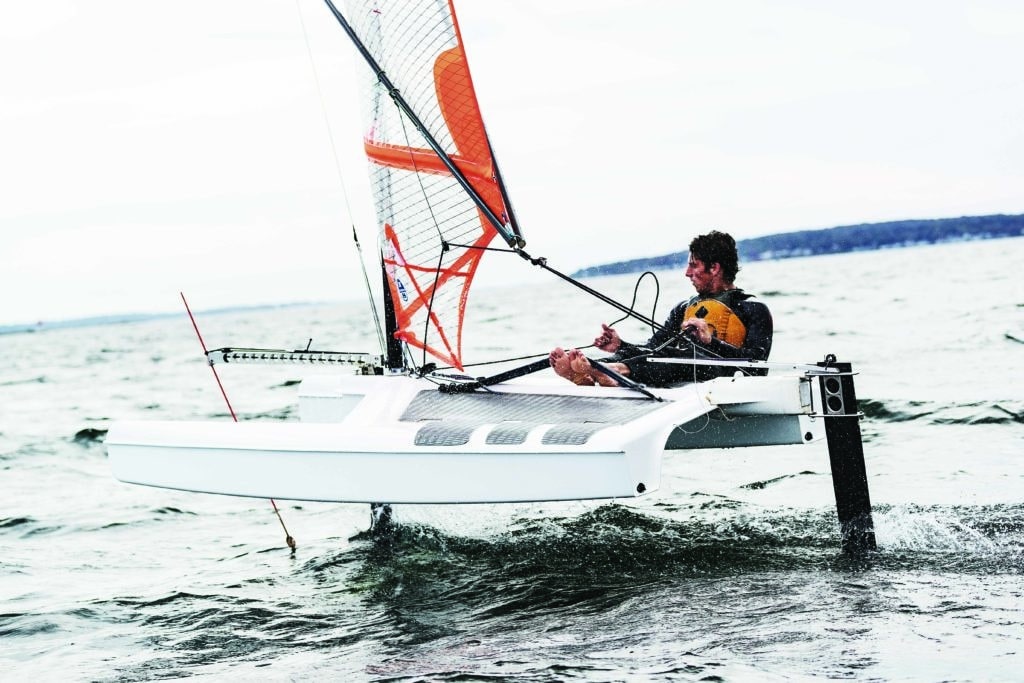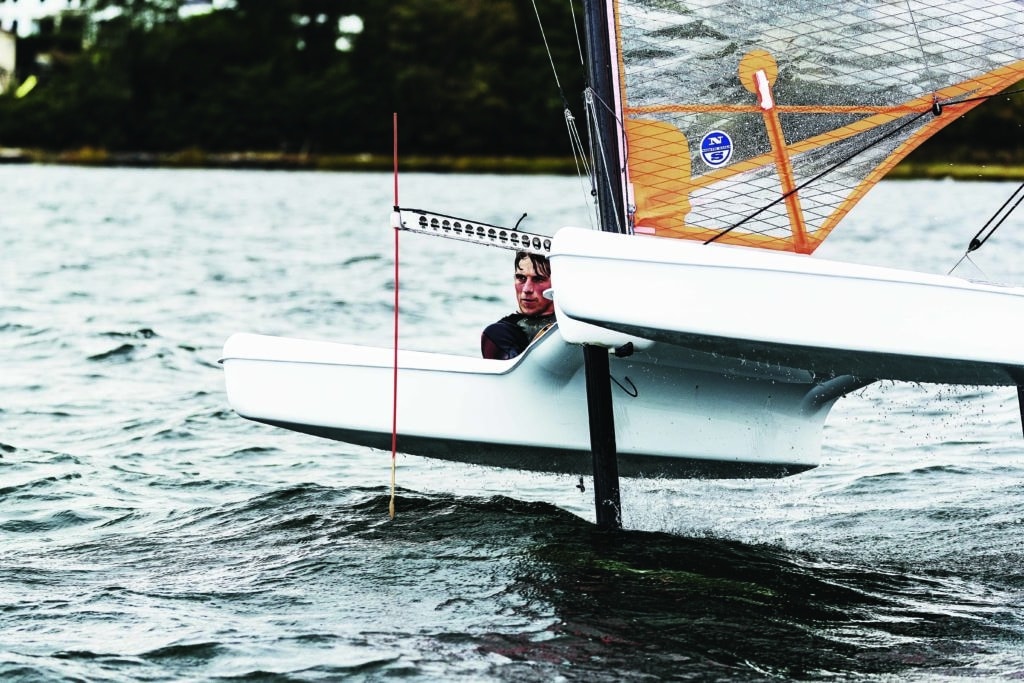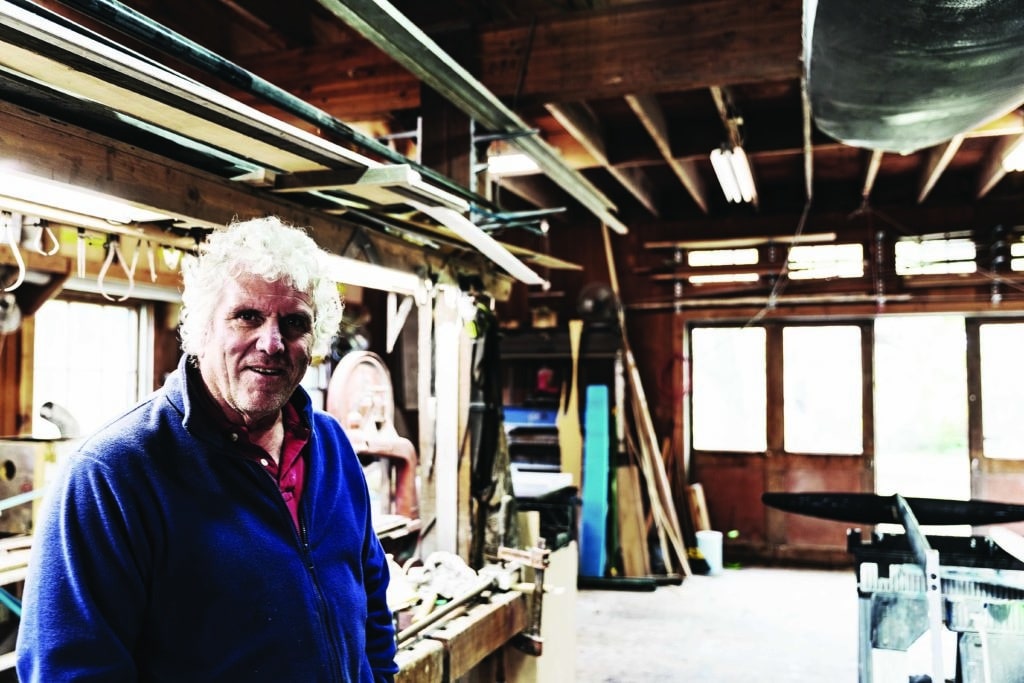
Farm in Warren, Rhode Island, is 92 acres of agricultural land, but it’s also a field of dreams. Thirty years ago, boatbuilding pioneer Steve Clark could have bought a medium-size home in an upscale community for what he paid for this spread, but he had less conventional aspirations. When it comes to new ideas, new possibilities and new ways of thinking, the ground here has proved to be fertile.
In a simple old barn, flanked by newer temporary structures, Steve and co-conspirators have upset the status quo many times before, especially with their C-class catamaran built for the Little America’s Cup. The boat was named Cogito, which is Latin for “I think.”
Thinking, followed by action, is what the Clark gene is all about.
Until 1996, Australia had a 10-year streak of winning the Little America’s Cup, and Steve was an underdog. He couldn’t outspend the Aussies, so he out-thought them and brought the cup home. Four other C-class catamarans have been dreamed up and built since Cogito’s victory. Steve’s most recent platform is Aethon, named after the eagle that tortured Prometheus in Greek mythology.
On a crisp fall day when the leaves at Point Farm are changing color and the light is long and low, Steve takes a break from his shop and sits down at a table to discuss his latest obsession.
On the picnic table is a mobile spinning in the breeze. Hand-built by Steve, the mobile is inverted in the shape of a U. Why? Steve grins. “I made it upside-down so it smiles,” he says.
Steve’s latest project is to bring foiling to the masses. He knows a thing or two about small boats. He started out as a bespoke boatbuilder, creating one to four boats per year. He couldn’t make a living at it, so he bought Vanguard with Chip Johns.
When Steve made the transition from custom builder to manufacturer, Peter Harken gave him some sage advice. “Any a—— can make one,” he said. “After you’ve built 100 that are the same, come talk to me.” At Vanguard, Steve went from four boats a year to four boats a day, and peaked production at 3,000 boats per year. As his workshop became a factory, he decided he needed his own space, so he erected a barn on his farm where he now creates one prototype boat at a time. It’s his own think tank.
Despite his high-tech weekend activities, Steve came to appreciate the simplicity of the Sunfish, one of Vanguard’s most successful offerings. “Look, it’s this scuzzy little thing, but everyone’s sailing it, and with a little bit of thought, the thing is in the Laser world of performance,” he says. “With the boom up high, it’s less hostile than a Laser, and two to four little kids can sail around in it. Then Dad comes home and lowers the boom and can reach across the bay at 10 knots and feel like he is Paul Elvstrøm.”
Steve’s son David, a tall, lean and mop-headed spitting image of his old man, joins the conversation. He is 24 years old, and when his dad goes off on a tangent, he tries to get him back to the point. Not happening. David Clark grew up in a place where instead of a large box of Legos, he had a boat barn full of possibilities. “Growing up in the workshop, I refer to it as the Johnny Quest lifestyle. I was enjoying exotic technology,” he says. “It was great. But I was immensely blasé about what was fun in sailing.”

That all changed when David sailed in a Moth in 2007. He got hooked on foiling and immediately started building a Moth of his own. After his first experience, he says, sailing became something completely different. “Foiling has added a Z-axis to the sport, and the flying could not be allowed to stop,” he explains.
While the Moth gave him immense satisfaction, David recognized its drawbacks: Everything about it was technical, from launching it to foiling, tacking, jibing and maintenance.
Steve characterizes the Moth and the new lower-tech Waszp as “cranky f—— little boats with a 12-inch waterline. They’re a constant war, from launch to landing — the emergency that starts at the dock.”
Like his father, David disregards the status quo. He believes the sailing industry has been talking about the Laser and the Windsurfer for 30 years now, and they are both “elderly technologies.” He suggests to his father that, as a former builder of the Laser, he should offer customers a Laser/coffin conversion kit because the people who sail them do so until they die.
David’s idea of inventing a boat that would bring foiling to the masses sounded good to his elder. After all, the design brief Steve created for himself at Vanguard when he worked on the Vector skiff was “I want kids to skip school to go sailing.” David’s first CAD drawing of the new boat was complicated, such that he could come about with the foil retracted inside the mast. His dad looked at it and suggested he put foils on something simple. Then he said: “Excuse me for a second while I blow your mind. What about a tunnel-hulled catamaran, put the daggerboard just forward of the mast, and the whole system withdraws between the hulls?” David stopped for a second and thought: “Damn it, he’s right. I have to start from scratch. That is an inherently better idea.”
Before there was a finished boat, there was a name. “I dug my heels in here on the UFO name,” says David. “I got on a Moth and it changed my life entirely. I’d flown for the first time, and I loved the idea of a UFO sighting. It had a sense of fun and adventure to it. I thought having this little spaceship would completely change sailing, this sense of exploring, this sense of a new space that we haven’t encountered yet. That’s what foiling has done for me.” David went to work on the computer to design the UFO. His goal was to create a boat that was stable, easy to use and safe, and which would foil all the time and be “Sunfish simple.”
From a pricing point of view, he wanted the boat to cost less than $7,000.
From a practical point of view, “Sunfish simple” meant you could rig and launch the boat yourself, and if you wanted to stop on the water to eat a sandwich, you could do so without swimming.
When father and son work together in the barn, they do not discuss pro sports teams or politics. They banter about things like Gray’s paradox: Sir James Gray observed dolphins swimming at speeds of up to 20 knots; based on his calculations, however, the dolphins did not have the strength to accomplish the feat.
Gray’s paradox leads them to discuss how some sails are “magic.” One theory they discuss is how one sail may be faster than others because the vibration of the leech can reduce some boundary layer that might reduce drag. They spitball ideas back and forth, from sail design to hull form to foil details. They pick up parts in the shop, use the sailor’s universal hand language to describe a boat’s performance, and complete each other’s sentences.

After a limited amount of design review for the UFO, they took it to the next level. Conventional behavior is to create a design in CAD, build a prototype, check it, and then build it. The Clarks believe in “sketching it out in real life.” Their prototype of the first UFO was a 20-day build.
They cannibalized David’s Moth project for the hulls. To hold the two hulls together, they used failed Laser Radial lower sections scavenged from Steve’s days at Vanguard. The centerline pod came off a mold for Aethon. The rig was a prototype from an International Canoe, spliced into a Laser lower section. There is a Sanford and Son caliber of pack-ratting on the farm, and small-boat parts are everywhere.
On the first test sail of the first UFO prototype (aka “the Probe”), David turned it up on a reach and the boat foiled immediately. Dad turned to his son and said: “You did it, Dave. Oh my god, you f—— beauty!”
Upon reflection, says David: “On my side of this, I am unspeakably proud to be my father’s son. Dad’s knowledge, creativity and will are kind of unparalleled. Cracking a unique problem like this, it’s important we have this level of adhesion between us.”
After the Probe, Steve saw that he and David had something that foiled with a human being on it, but it needed to be refined. “We have a riff now, but we do not have a song yet,” he says. David would not be satisfied until the UFO foiled both upwind and downwind.
To refine the details, they built four more UFO prototypes, and each sits in the yard, the latest evolution in sailing resting against a stone wall that has not moved in hundreds of years. About the five prototypes, David says: “The two conditions for rapid evolution are rapid reproduction and rapid attrition. Things need to be made and things need to be killed.”
Just up the street, Zim Boats is now building the first production boat. In many ways, the Zim of today is a lot like the Vanguard of the past, where Steve worked. There are a lot of the same people on staff, including lead builder Greg Ormond, whom Steve taught to build boats when Greg was younger than David. Together, David and Greg built the first UFO with vinylester-infused fiberglass, a Soric core, and carbon fiber in the high-stress areas. Thus far, response to the UFO is positive. David reads an email he received from a prospective buyer at the Rush Creek YC in Rockwall, Texas, who wants to know how many boats he needs to purchase to get David to come give a clinic. The answer is three.
While David is happy to hear from a yacht club, his goal is to create demand from the general population. With a smile, he says: “I just showed a video of the UFO to the guy changing my oil, and he was totally into it and he doesn’t sail at all. He hasn’t touched a boat in his life.”
Steve and David Clark have created what they believe to be an affordable, safe, accessible boat that enables everyday people to fly, but they won’t be satisfied until the UFO lands to take the sport of sailing to new heights.









